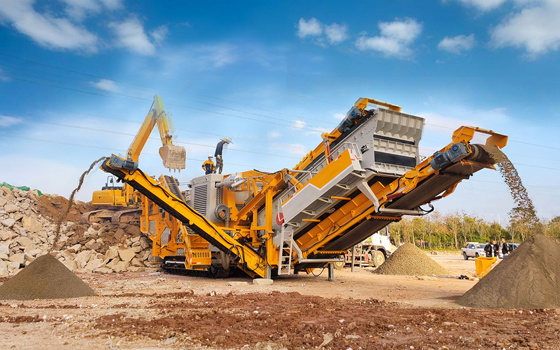Maximize Performance by Understanding Impact Crusher Parts: A Comprehensive Guide
Release Time:
2025-08-06
Author:
Source:
Maximize Performance by Understanding Impact Crusher Parts Table of Contents 1. Introduction to Impact Crushers 2. Importance of Understanding Impact Crusher Parts 3. Main Parts of an Impact Crusher 3.1 Blow Bars 3.2 Impact Plates 3.3 Rotor 3.4 Frame 4. Enhancing Operational Efficiency 5. Maintenance Practices for Longevity 6. Co
Maximize Performance by Understanding Impact Crusher Parts
Table of Contents
- 1. Introduction to Impact Crushers
- 2. Importance of Understanding Impact Crusher Parts
- 3. Main Parts of an Impact Crusher
- 3.1 Blow Bars
- 3.2 Impact Plates
- 3.3 Rotor
- 3.4 Frame
- 4. Enhancing Operational Efficiency
- 5. Maintenance Practices for Longevity
- 6. Common Issues and Troubleshooting
- 7. Frequently Asked Questions
- 8. Conclusion
1. Introduction to Impact Crushers
Impact crushers are vital pieces of equipment in the manufacturing and processing sectors, particularly in the industries of construction and mining. These machines are designed to crush materials by striking them against surfaces at high speeds. Understanding the intricate design and functionality of impact crushers can lead to improved operational efficiency and reduced downtime.
2. Importance of Understanding Impact Crusher Parts
To maximize performance, it’s crucial to comprehend the various components of an impact crusher. Every part plays a significant role in the overall functionality and effectiveness of the machine. By familiarizing ourselves with these parts, we can optimize their usage, enhance productivity, and prolong the life of the equipment.
3. Main Parts of an Impact Crusher
An impact crusher consists of numerous critical components. Here, we will discuss each part in detail, illuminating their functionality and contribution to the machine's performance.
3.1 Blow Bars
Blow bars are essential components responsible for the crushing action in impact crushers. These parts are typically made of high-grade steel and are designed to withstand high-impact forces. The shape and material of the blow bars can significantly influence the efficiency of the crushing process.
Types of Blow Bars
- **High Chrome Bars**: These are ideal for crushing highly abrasive materials and offer excellent wear resistance.
- **Martensitic Steel Bars**: These bars provide a balance between toughness and wear resistance, making them effective for various materials.
- **Ceramic Blow Bars**: Utilized for specific applications, these bars enhance impact resistance and prolong service life.
3.2 Impact Plates
Impact plates, also known as impact curtains or impact aprons, serve as barriers that redirect the material being crushed. The design of impact plates plays a vital role in controlling the size of the output material. Proper adjustment and maintenance of impact plates can significantly affect the performance of the crusher.
3.3 Rotor
The rotor is the heart of the impact crusher, responsible for transferring energy to the material being crushed. It rotates at high speed, utilizing centrifugal force to propel the material against the blow bars. The rotor’s design must be robust to endure the stresses it faces during operation.
Key Features of an Effective Rotor
- **Weight and Balance**: A well-balanced rotor minimizes vibrations and enhances operational stability.
- **Material Construction**: The rotor must be constructed from high-strength materials to withstand wear and tear.
3.4 Frame
The frame of the impact crusher provides structural support for all other components. A strong, durable frame is essential for maintaining the integrity of the machine during operation. Frames are typically made from heavy-duty steel to ensure longevity and resilience.
4. Enhancing Operational Efficiency
Improving the operational efficiency of your impact crusher involves a combination of understanding its parts and implementing effective practices. Here are some strategies to enhance performance:
Optimize Feed Size
The size of the material fed into the crusher can greatly affect its efficiency. Ensuring that the feed material is within the recommended size range can lead to smoother operations and less wear on components.
Regularly Monitor Wear Parts
Constant monitoring of wear parts like blow bars and impact plates is essential. Early detection of wear can help in scheduling timely replacements, preventing unexpected breakdowns.
Adjust Settings for Desired Output
Adjusting the gap between the blow bars and impact plates can help control the size of the output material. Regularly assessing and adjusting these settings based on the material being processed can lead to improved product quality.
5. Maintenance Practices for Longevity
Regular maintenance is critical for the longevity and efficiency of impact crushers. Implementing a solid maintenance schedule can save time and costs in the long run.
Daily Inspections
Conducting daily inspections of the crusher can help identify any potential issues before they escalate. Checking for unusual vibrations, noise, or wear can keep the machine operating smoothly.
Scheduled Maintenance
Establishing a routine maintenance schedule that includes lubrication, part replacements, and thorough cleaning can prolong the life of the impact crusher and maintain its performance.
Training Operators
Investing in training for operators ensures they understand the machine's components and operations, minimizing human error and optimizing performance.
6. Common Issues and Troubleshooting
Impact crushers can face various issues that may hinder performance. Here are some common problems and how to address them:
Excessive Wear on Blow Bars
If blow bars wear out quickly, it could be due to abrasive materials being processed or improper settings. Regularly check the feed material and adjust settings as necessary.
Vibrations and Noise
Excessive vibrations can indicate unbalanced rotors or worn-out components. Perform a thorough inspection and replace any damaged parts immediately.
Low Production Rates
If production rates drop, it may be due to blockage in the feeding system or wear in critical components. Inspect the system and clear any blockages to restore efficiency.
7. Frequently Asked Questions
What is the role of blow bars in an impact crusher?
Blow bars are critical components that directly crush the material by striking it at high speeds. Their material and design influence the efficiency and wear resistance of the crusher.
How often should I replace blow bars?
Replacement frequency depends on the type of material processed and operational conditions. Regular monitoring for wear will help determine when replacements are necessary.
What maintenance should I perform on my impact crusher?
Regular inspections, lubrication, part replacements, and cleaning are essential for maintaining an impact crusher's performance and longevity.
Why is the rotor important?
The rotor is crucial for transferring energy to the crushing process. Its design and balance affect the overall efficiency and stability of the machine.
How can I improve the efficiency of my impact crusher?
You can enhance efficiency by optimizing feed size, monitoring wear parts, adjusting settings for desired output, and performing regular maintenance.
8. Conclusion
Understanding the various parts of an impact crusher is paramount for maximizing performance and efficiency. By delving into the roles of key components such as blow bars, impact plates, rotors, and frames, operators can make informed decisions that lead to improved productivity and reduced operational costs. Incorporating regular maintenance practices further ensures the longevity of the equipment, allowing for continuous high performance in demanding environments. With these insights, we can confidently navigate the complexities of impact crusher operations and achieve optimal results.
Keywords:
Jaw crusher parts | Shredder parts | Cone crusher Parts | Ball mill parts
Related News
Business License









